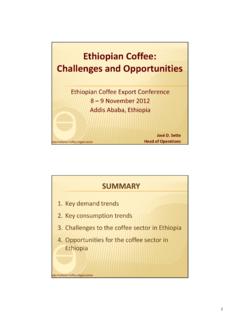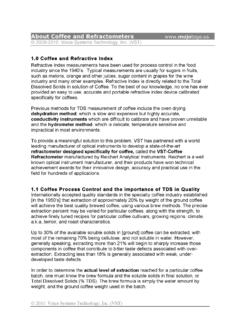Transcription of Carbon Footprint Across the Coffee Supply Chain: …
1 Carbon Footprint Across the Coffee Supply Chain: The Case of Costa Rican CoffeeTrack: Supply -Chain and Operation ManagementKey words: Carbon Footprint , Coffee Supply chain, Costa 2012 Carbon Footprint Across the Coffee Supply Chain: The Case of Costa Rican CoffeeAbstractThe issue of Carbon emissions has been on the corporate sustainability agenda for some years. For those working in agricultural Supply chains the challenges remain significant, given the diverse direct and indirect emissions occurring throughout the value chain. This study determines the Carbon Footprint of the Supply chain of Costa Rican Coffee exported to Europe, using best practice methodology to calculate greenhouse gas emissions. Overall it was found that the total Carbon Footprint Across the entire Supply chain is kg CO2e/kg green Coffee . The Carbon Footprint of the processes in Costa Rica to produce 1 kilogram of green Coffee is kg CO2e. The processes within Europe generate CO2e/kg green Coffee .
2 This Carbon Footprint is considered as very high intensity . This paper also identifies the sources of the most intense emission and discusses mitigation possibilities on which efforts must be focused. Key words: Carbon Footprint , Coffee Supply chain, Costa change is a known and largely accepted reality, and the world s climate will continue to change as long as greenhouse gas levels keep rising (UNFCCC, 2002). The effects of climate change are clearly perceivable, and impacts are being felt worldwide. This is especially so for communities dependent on climate for their livelihoods namely farmers. Human activity in industry and agriculture has much responsibility in this regard; agriculture directly contributes to approximately 10% - 12% of global greenhouse gas (GHG) emissions, according to the latest IPCC report (Smith and Martino, 2007). The growing public concern about climate change has given rise to responses from government and industry.
3 The corporate world has responded by starting to evaluate the global warming potential of their products. For those working in agricultural Supply chains the challenges remain significant, given the diverse direct and indirect emissions occurring throughout the value chain. In terms of GHG emissions, agriculture is a complex process that results in many direct non- Carbon dioxide emissions in addition to direct Carbon dioxide and indirect GHG emissions (DEFRA, 2011). This complexity is particularly significant in Coffee Supply chains, since Coffee beans change hands dozens of times on the journey from producers to consumer (Fairtrade, 2012). Over the last 20 years, with growing demand, there has been a move to greater intensification of Coffee growing and heavy use of agrochemicals (Consumers International, 2005), which led to an increase in environmental impacts at farm level. In the next stage of the Coffee Supply chain; a common practice for processing Coffee is the wet milling process.
4 Coffee produced through this method is regarded as being of better quality (Consumers International, 2005), but inherent in this method lays the significant challenge of properly managing the resulting effluent. Carbon Footprint has become a widely used term and concept to define responsibility and abatement action against the threat of global climate change (Wiedmann and Minx, 2008). A Carbon Footprint is obtained by quantifying GHG emissions produced during a defined period of time, which is then expressed in Carbon dioxide date, there is little information in scientific literature about Carbon emissions in the Coffee sector. Given this lack of information, this study is an attempt to understand Coffee s Carbon Footprint and to identify a response that helps to reduce impacts over main purpose of this study has been to determine the Carbon Footprint of a Costa Rican Coffee Supply chain using best practice methodology to calculate greenhouse gas emissions.
5 Its purpose was also to develop a tool to calculate GHG emissions in the Coffee Supply chain, to enable replication in other Coffee Supply chains as necessary. Additionally, the study sought to identify hot spots of GHG emissions in the Coffee Supply chain, in order to determine where mitigation efforts should be focused, and to evaluate alternatives of mitigation efforts and their impact on the Carbon meet these objectives, the study focused on different stages of the Coffee Supply chain: at farm level, in the central mill, and during the process of exportation. In order to assess the Carbon Footprint of the entire Coffee Supply chain, results of processes undertaken outside Costa Rica and within Europe were drawn from an existing study that evaluates the Carbon Footprint of Coffee exported to Germany (PCF Pilotprojekt Deutschland, 2008). Finally, it is worth noting that sustainability measures and Carbon reductions are still largely optional practices within Supply chains.
6 However, as consumers, NGOs and governments increasingly demand more of it, companies and stakeholders involved in the Coffee business will have to meet these expectations through greater efforts on sustainability practices and through lower Carbon emissions. The adaptability of the results of the present study and the calculation tool developed will be extremely valuable in evaluating Carbon Footprint in other ReviewThe current section synthesizes published information related to Carbon footprints. It summarizes public knowledge on greenhouse gas emissions, the impact of Coffee in terms of Carbon emissions, the definition of Carbon Footprint and Carbon Footprint methodologies as well as the theoretical base and understanding of the topic. Greenhouse Gas Emissions The effects of climate change are clearly perceivable and accelerating. Whereas all of these changes cannot be attributed to human activities only, it has to be acknowledged that the accelerated concentration of Carbon dioxide (CO2) particles in the atmosphere which reached 389 ppm in September 2011 (ESRL, 2012a) and the implications of altering natural lifecycles, have not occurred randomly.
7 The United Nations Framework Convention on Climate Change (UNFCCC) acknowledges in its definition of climate change that the change of climate is attributed directly and indirectly to human activity, which alters the composition of the global atmosphere (UNFCCC, 1992). Levels of all key greenhouse gases are rising as a direct result of human activities (UNFCCC, 2002).Of the greenhouse gases, CO2 is of greatest concern because it contributes the most to enhanced greenhouse effect and climate change (ESRL, 2012b). Currently, Carbon dioxide is responsible for over 60% of the enhanced greenhouse effect, mostly from the burning of fossil fuels (UNFCC, 2002). Deforestation is the second largest source of Carbon dioxide, when forests are cleared for agriculture or development. The production of lime to make cement accounts for 3% of CO2 emission from industrial sources (IPCC, 2005). Methane is the second most abundant GHG after Carbon dioxide (Global Methane Initiative, 2010).
8 Domesticated animals (cattle) emit methane, which is produced by enteric fermentation of food by bacteria and other microbes in the animals digestive tracts. The decomposition of manure also releases methane. Other sources of methane include wetland rice farming by the decomposition of organic matter in the flooded soil, disposal and treatment of garbage and human wastes by anaerobic decomposition (UNFCCC, 2002).Nitrous oxide is an important anthropogenic GHG and agriculture represents its largest source (Reay et al., 2012). Part of that nitrous oxide is produced by the use of fertilizers and manures. The nitrogen contained in those products enhances the natural process of nitrification and denitrification. Bacteria and other microbes in the soil carry out this process to convert part of the nitrogen into nitrous oxide (Willey and Chameides, 2007). Chlorofluorocarbons (CFCS), hydrochlorofluorocarbons (HCFCs), hydrofluorocarbons (HFCs), perfluorocarbons (PFCs) and sulfur hexafluoride (SF6) are long-lived and potent greenhouse gases; very small emissions of these gases relative to CO2 can have a large climate impact (Field and Raupach, 2004).
9 Agriculture directly contributes to approximately 10% - 12% of global greenhouse gas emissions, according to the latest IPCC report (Smith and Martino, 2007). Agricultural practices generate the greenhouses gases from Carbon dioxide (CO2) linked to land conversion, soil management and energy use, nitrous oxide (N2O) connected to the use of fertilizers, and methane (CH4) which is mainly related to waste management of the product (Flessa et al, 2002). Globally, agricultural methane (CH4) and nitrous oxide (N2O) emissions increased by nearly 17% from 1990 to 2005 (Smith and Martino, 2007). According to the Carbon Dioxide Information Analysis Center (CDIAC), Costa Rica emitted about 2000 thousand metric tones of Carbon during 2010 and an average of metric tones of Carbon per capita (CDIAC, 2012). Greenhouse gas emissions from agriculture represent approximately 39% of the Costa Rican emissions, according to the national inventory of GHG emissions carried out in 2005 (Chac n, Montenegro, and Sasa, 2009).
10 Impact of Coffee in terms of Carbon EmissionsCoffee is the world s most widely traded tropical agricultural commodity (ICO, 2011). In the world economy, the Coffee trade was worth approximately US$ billion by 2010 (ITC, 2011). It is a major source of revenue for more than 40 tropical countries, and it generates more than 120 million jobs (CIRAD, 2012). Around 125 million people worldwide depend on Coffee for their livelihoods (Fairtrade, 2012) and people are involved in the sector from farm level through to processing and sale (Consumers International, 2005). According to CIRAD (2012), Coffee is grown on more than 10 million hectares worldwide. The world production for 2011/2012 was estimated at million bags (ICO, 2012a), and the USDA (2012) has forecasted a record 148 millions bags of Coffee worldwide for the 2012/2013 harvest. Coffee is particularly important to the Costa Rican export portfolio. In 2010 dry green coffee1 exports were ranked 9th in terms of importance and represented of the total value of agricultural exports and of the total exportation of the country (PROCOMER, 2011).






